#50 follower spectacular
Explore tagged Tumblr posts
Text
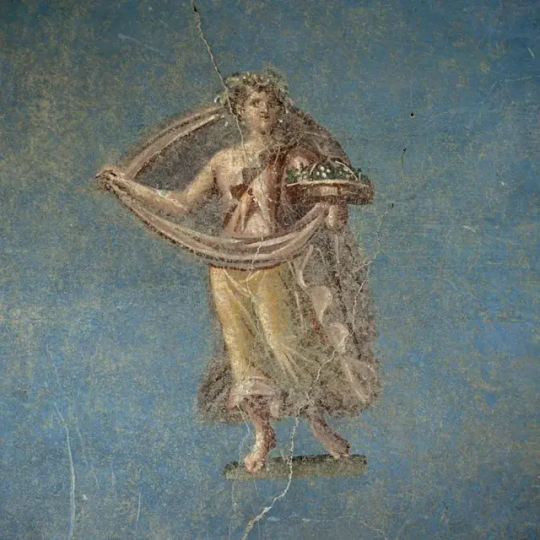




'Once-in-a-Century' Discovery Reveals Luxury Bathhouse in Pompeii
After lying hidden beneath metres of volcanic rock and ash for 2,000 years, a "once-in-a-century" find has been unearthed in the ancient Roman city of Pompeii in Italy.
Archaeologists have discovered a sumptuous private bathhouse - potentially the largest ever found there - complete with hot, warm and cold rooms, exquisite artwork, and a huge plunge pool.
The spa-like complex sits at the heart of a grand residence uncovered over the last two years during a major excavation.
"It's these spaces that really are part of the 'Pompeii effect' - it's almost as if the people had only left a minute ago," says Dr Gabriel Zuchtriegel, director of the Archaeological Park of Pompeii.

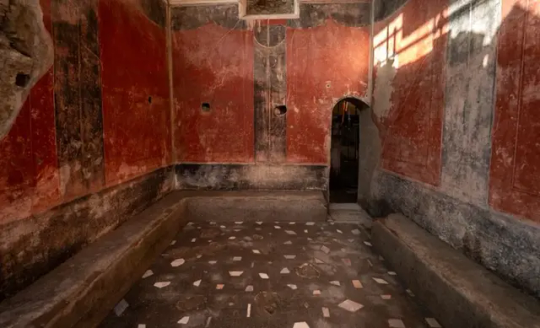
The bathhouse changing room has vibrant red walls, a mosaic floor and stone benches
Analysis of two skeletons discovered in the house also shows the horror faced by Pompeii's inhabitants when Mount Vesuvius erupted in AD79.
The bodies belonged to a woman, aged between 35 and 50, who was clutching jewellery and coins, and a younger man in his teens or early 20s.
They had barricaded themselves into a small room, but were killed as a tsunami of superheated volcanic gas and ash - known as a pyroclastic flow - ripped through the town.
"This is a dramatic place, and everything you find here tells you about the drama," says Pompeii conservator, Dr Ludovica Alesse.
A third of the ancient city still lies hidden beneath volcanic debris from the disaster, but the new excavation - the most extensive in a generation - provides new insights into ancient Roman life.
The archaeologists have been followed by a documentary team from the BBC and Lion TV, for a series called Pompeii: The New Dig.




An entire block of Pompeii has now been uncovered, revealing a laundry and bakery, as well as the large private house. It's thought these were all owned by one wealthy individual, possibly Aulus Rustius Verus, an influential Pompeii politician.
The discovery of the bathhouse is further confirmation of his elite status, says Dr Zuchtriegel.
"There are just a few houses that have a private bath complex, so it was something really for the wealthiest of the wealthy," he says. "And this is so huge - it's probably the biggest bath complex in a Pompeiian private home."Those lucky enough to use the suite of bathing rooms would have undressed in a changing room with vibrant red walls and a mosaic floor dotted with geometric patterns inlaid with marble from across the Roman Empire.



Twenty to 30 people could bathe in the cold room's plunge pool, which is more than 1m deep
They would then head to the hot room, taking a dip in a bath and enjoying the sauna-like warmth, provided by a suspended floor that allowed hot air to flow underneath and walls with a cavity where the heat could circulate.
Next they would move to the brightly-painted warm room, where oil would be rubbed into the skin, before being scraped off with a curved instrument called a strigil.
Finally, they would enter the largest and most spectacular room of all - the frigidarium, or cold room. Surrounded by red columns and frescoes of athletes, a visitor could cool off in the plunge pool, which is so large 20-30 people could fit in it.
"In the hot summers, you could sit with your feet in the water, chatting with your friends, maybe enjoying a cup of wine," says Dr Zuchtriegel.
The bathhouse is the latest find to emerge from this extraordinary house.
A huge banqueting room with jet black walls and breathtaking artwork of classical scenes was found last year. A smaller, more intimate room - painted in pale blue - where residents of the house would go and pray to the gods was also unearthed.
The residence was mid-renovation - tools and building materials have been found throughout. In the blue room a pile of oyster shells lie on the floor, ready to be ground up and applied to the walls to give them an iridescent shimmer.


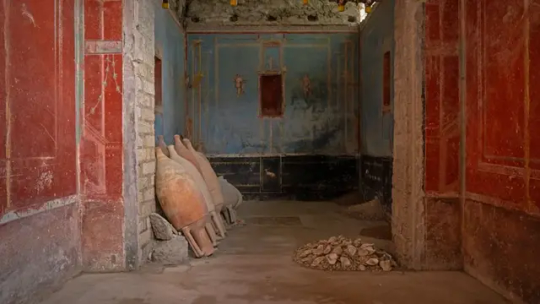
A small blue room used for prayer. Amphoras - terracotta containers used to transport olive oil or wine - are resting against a wall. Oyster shells are piled on the floor
Next door to this beautiful space, in a cramped room with barely any decoration, a stark discovery was made - the remains of two Pompeiians who failed to escape from the eruption.
The skeleton of a woman was found lying on top of a bed, curled up in a foetal position. The body of a man was in the corner of this small room.
"The pyroclastic flow from Vesuvius came along the street just outside this room, and caused a wall to collapse, and that had basically crushed him to death," explains Dr Sophie Hay, an archaeologist at Pompeii.
"The woman was still alive while he was dying - imagine the trauma - and then this room filled with the rest of the pyroclastic flow, and that's how she died."

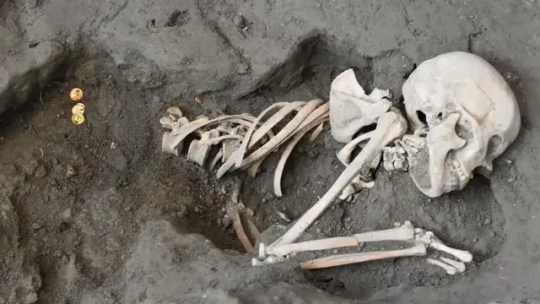
The skeleton of a woman, clutching coins, was found curled in a foetal position
Analysis of the male skeleton showed that despite his young age, his bones had signs of wear and tear, suggesting he was of lower status, possibly even a slave.
The woman was older, but her bones and teeth were in good condition.
"She was probably someone higher up in society," says Dr Hay. "She could have been the wife of the owner of the house - or maybe an assistant looking after the wife, we just don't know."
An assortment of items were found on a marble table top in the room - glassware, bronze jugs and pottery - perhaps brought into the room where the pair had tucked themselves away hoping to wait out the eruption.
But it's the items clutched by the victims that are of particular interest. The younger man held some keys, while the older woman was found with gold and silver coins and jewellery.
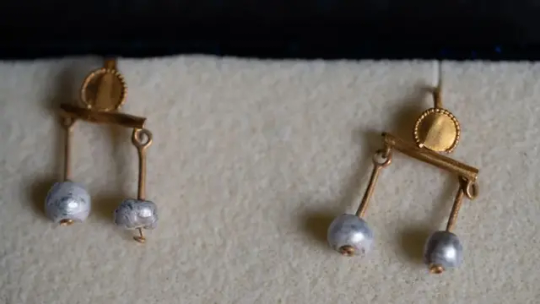
A pair of gold and natural pearl earrings found close to the female skeleton
These are kept in Pompeii's vault, along with the city's other priceless finds, and we were given a chance to see them with archaeologist, Dr Alessandro Russo.
The gold coins still gleam as if they were new, and he shows us delicate gold and natural pearl earrings, necklace pendants and intricately etched semi-precious stones.
"When we find this kind of object, the distance from ancient times and modern times disappears," Dr Russo says, "and we can touch a small piece of the life of these people who died in the eruption."

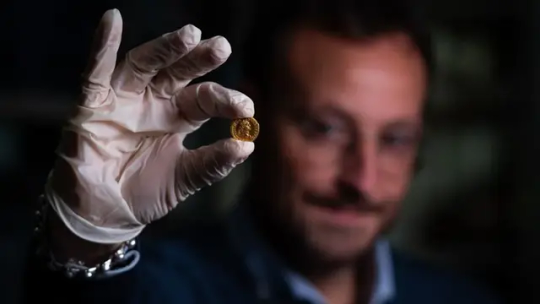
Archaeologist Alessandro Russo holds a gold coin found with the female skeleton
Dr Sophie Hay describes the private bathhouse complex as a once-in-a-century discovery, which also sheds more light on a darker side of Roman life.
Just behind the hot room is a boiler room. A pipe brought water in from the street - with some syphoned off into the cold plunge pool - and the rest was heated in a lead boiler destined for the hot room. The valves that regulated the flow look so modern it's as if you could turn them on and off even today.
With a furnace sitting beneath, the conditions in this room would have been unbearably hot for the slaves who had to keep the whole system going.
"The most powerful thing from these excavations is that stark contrast between the lives of the slaves and the very, very rich. And here we see it," says Dr Sophie Hay.

Pipework and taps in the residence's boiler room
"The difference between the sumptuous life of the bathhouse, compared to the furnace room, where the slaves would be feeding the fire toiling all day.
"A wall is all that could divide you between two different worlds."
The excavation is in its final weeks - but new discoveries continue to emerge from the ash. Limited numbers of visitors are allowed to visit the dig while it's ongoing, but eventually it will be fully opened to the public.
"Every day here is a surprise," says Dr Anna Onesti, director of the excavation.
"Sometimes in the morning I come to work thinking that it's a normal working day - and then I discover we found something exceptional.
"It's a magic moment for the life of Pompeii, and this excavation work offers us the possibility to share this with the public."
By Rebecca Morelle and Alison Francis.


#Pompeii#'Once-in-a-Century' Discovery Reveals Luxury Bathhouse in Pompeii#mosaic#gold#roman gold coins#roman gold jewelry#ancient jewelry#ancient artifacts#archeology#archeolgst#history#history news#ancient history#ancient culture#ancient civilizations#roman history#roman empire#roman architecture#roman art#ancient art#long post#long reads
179 notes
·
View notes
Note
I know of and respect your dislike of the Daredevil tv series, but I wanted to ask if you might have reading recs to familiarize myself with what the Born Again series is planning. Heather Glenn, Muse, Mayor Fisk, etc. I've read some relevant comics, but I'm not sure if I'm missing something important. What runs and issues might I need to hit? ♥
I mean, listen, "dislike" is a strong word. There was a time when this show was very fun to me. If it were to stop filtering into the comics, and if Marvel stopped treating the other Netflix shows like second-rate afterthoughts, it might become fun to me again. Regardless, I'm always thrilled to help with things like this!
Heather Glenn

Heather was introduced in Daredevil volume 1 #126, when she wandered into her ex-boyfriend's apartment and found Matt living there instead. She became a member of the core Daredevil cast, dating Matt and serving as an assistant at the law firm. She was tragically central in Matt's earliest life-falls-apart storylines, and remained an important recurring character for a span of roughly 80-or-so issues. In other words, she's a pretty big deal, and I'm excited to learn she will be making the leap to the MCU. (Heather's family's company, Glenn Industries, was actually mentioned in Luke Cage season 2. But referencing that would require them to, you know, acknowledge the existence of Luke Cage, so we'll see.)
Heather's appearances include: Daredevil volume 1 #126-132, 134-138, 141-154, 157-160, 165-167, 169, 171, 174-177, 182-186, 189, 195, and 220. In particular, you'll want to check out #147-154 and 182-186, 189.
Muse

Muse was introduced in Daredevil volume 5 #10 as a terrifyingly dangerous antagonist for budding superhero Blindspot/Sam Chung (who was already introduced to the MCU in Iron Fist season 2!), and appeared in issues #10-14 and #596-600 (don't let the high numbers alarm you— this took place during a period when all of Marvel's comics briefly switched to their legacy numbering). Muse is also now being brought back in the current Daredevil: Unleash Hell mini-series starring Elektra.
Mayor Fisk

The "Mayor Fisk" plotline is also from Daredevil volume 5. Volume 5 was the first Daredevil run to come out following the release of the show, which had a noticeable impact on both the writing and art, so it's fascinating to see it now impacting the show in such a big way in return. Truly, a full circle. The initial story arc is covered in issues #595-600, but Fisk remained the mayor all the way through the end of volume 5 and all of volume 6 before finally being defeated in the next election in Devil's Reign— a story that was centered around Mayor Fisk's draconian laws against superheroes.
White Tiger(s)

I've also heard mention of a White Tiger appearance? This is an extremely cool superhero legacy born out of the era of Marvel's kung fu superheroes alongside Shang-Chi, Iron Fist, the Daughters of the Dragon, and the Sons of the Tiger (who are also tied into the White Tiger legacy). The White Tigers wield martial arts mastery and superhuman enhancements channeled from a magical amulet. The first White Tiger, Hector Ayala, was introduced in the Deadly Hands of Kung Fu anthology magazine exactly 50 years ago this year! While definitely a product of its time, DHKF was notable for cultivating and promoting a diverse cast of protagonists, and Hector was Marvel's very first Latino superhero. His origin story begins in #19, at the end of the issue's Sons of the Tiger comic installment, and then continues in #20-24, 26-27, and 29-32. He also appeared in Peter Parker: The Spectacular Spider-Man volume 1 #9-10, 18-32, and 49-52, starred in the retrospective story "Pa'lante Juntos" in Marvel's Voices: Comunidades in 2021, and— possibly most relevant, in this instance— was at the center of the Daredevil story arc "The Trial of the Century" (Daredevil volume 2 #38-40).
That story was followed soon afterward by the introduction of the second White Tiger, Hector's niece, Angela Del Toro (who was actually already name-dropped in Jessica Jones!). She appeared in Daredevil volume 2 #59, 65-70, 77-79, 113-115, 119-510, had her own White Tiger mini-series, and has appeared in a few other places as well (notably, Shadowland and New Avengers (2015)). The third White Tiger is Angela's aunt, Ava Ayala, who was introduced in Avengers Academy (2010) #21 and also appeared in Mighty Avengers, Captain America and the Mighty Avengers, and New Avengers (2015), as well as having her own story in Marvel's Voices: Comunidades. (She was also a main character in the Ultimate Spider-Man cartoon.) Finally, there is another White Tiger, just named "White Tiger", a literal anthropomorphic tiger who was introduced in Heroes for Hire volume 1. She's not connected at all to the previously established White Tiger legacy, and if she somehow gets referenced in this Daredevil show, I will put ketchup on my copy of Mike Murdock's introductory issue and eat it. (But you should read Heroes for Hire volume 1 anyway, because it's really fun.)
Kirsten McDuffie

Is Kirsten also still in this? I recall a time when sources claimed she was in this. Regardless, everyone should read some Kirsten McDuffie comics. They're good for your health. Kirsten was introduced in Daredevil volume 3 #1 and was part of the core cast in all of volume 3, Daredevil: Road Warrior, and volume 4, plus Daredevil: Dark Nights #4-5, then reappeared in Daredevil volume 5 #17-20, Man Without Fear (2019) #2, Daredevil volume 6 #23-24 and a few other scattered issues afterward, Devil's Reign #3-5 and Devil's Reign: Omega.
"Born Again"
The new season is called "Born Again", so I guess you should read "Born Again" (Daredevil volume 1 #227-233)? Even though season 3 already kind of adapted it? Either way, it's a great, classic story arc that I recommend checking out if you haven't.
I hope this helps! Please don't hesitate to ask about any other references that interest you. I'm not sure I'll be actively seeking them out myself, but I'm very happy to receive and talk about them.
#Long post#MCU#Disney+ Daredevil#Daredevil#Heather Glenn#Muse#White Tiger#Hector Ayala#Angela Del Toro#Ava Ayala#Kirsten McDuffie#Recommendations List#Asks#ID in alt text
51 notes
·
View notes
Text
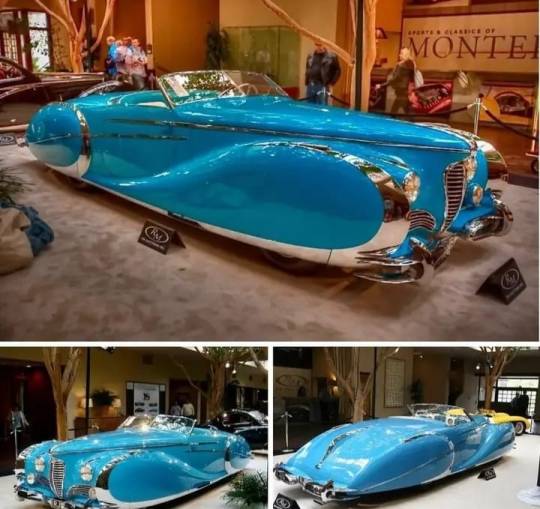
1949 Delahaye 175 S Saoutchik Roadster
Saoutchik was a cabinet maker when he moved to Paris from his home in Ukraine around 1900, but he didn’t take long to establish himself in the fledgling automotive coachbuilding industry and he showed a consistent flair over the next 50 years which puts him among the very elite of automotive designers.
His designs borrowed little from other designers, and along with names such as Figoni et Falaschi, Chapron, Franay and de Letourner et Marchand, Saoutchik was one of the foremost designers of exquisite Art Deco coachwork during the 20s and 30s.
Saoutchik was commissioned to produce the spectacular work-of-art by flamboyant English collector, Sir John Gaul. The design was based on the first post-war Delahaye chassis from a 175 S Roadster (chassis number 815023) producing 165 bhp from an engine much larger than the pre-war Delahayes ran – a 4,455 cc naturally aspirated overhead valve inline six cylinder engine with four-speed electro-mechanically actuated Cotal Preselector gearbox, Dubonnet coil spring front suspension, De Dion rear axle with semi-elliptic springs, and four-wheel hydraulic finned alloy drum brakes. The wheelbase was a whopping 116 inches.
The car was unveiled at the 1949 Paris Auto Show, and was exhibited at all the major European concours events that year, from Paris to Monte Carlo to San Remo, scooping the pool wherever it was exhibited. It won best-in-class in the Pebble Beach Concours d’Elegance in 2006 just a few months after a complete restoration. Just a few months later, the car was honored again, winning People’s Choice at theprestigious Amelia Island Concours d’ Elegance.
Having fulfilled its exhibition duties, it then passed through a succession of other flamboyant owners, including actress Diana Dors.
The final word on this stunning automobile goes to Ian Kelleher, President and Chief Operating Officer, RM Auctions
“Following the financial depression of World War II, there were few collectors with the means, flamboyance and flair to commission a car as exotic as this Saoutchik Roadster. Arguably the most desirable post-war, coachbuilt automobile of all time, it is truly a masterpiece of the coachbuilder’s art. Eye-catching and exotic, it is wonderful to drive and combines superlative styling on a chassis of competition quality.”
Courtesy of RM Auctions
94 notes
·
View notes
Text
Evie's Quacktacular Spectacular Celebration (A Competition for No Reason)
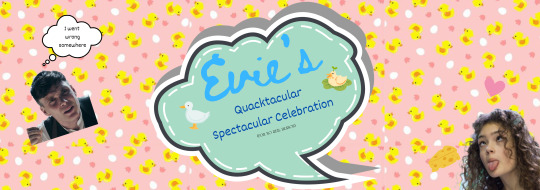
Ducks are beautiful(Tommy: Oh, dear God...). And I wanted to celebrate their existence. January 19th is National Duck Day and January 13th is National Rubber Ducky Day...which is bull shit! Everyday, under Evie, is duck day. Why? Because there is nothing greater than a duck and a slab of cheese...man, I love cheese, too. Cheese goes with everything. And ducks? Man's best friend(Tommy: That is a dog, Evie, a dog). IN EVIE LAND...ducks are a man's best friend......Anyway, let's look at 5 great things about ducks!
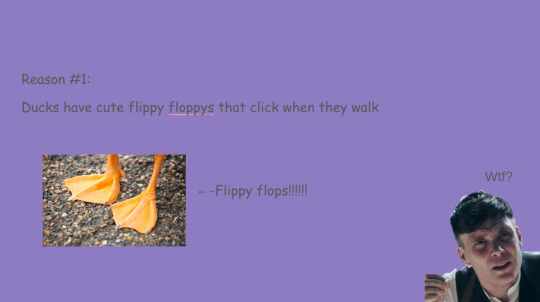
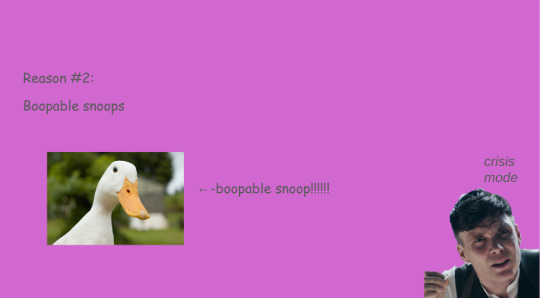
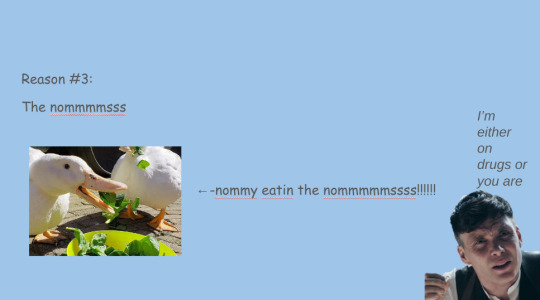

Any questions so far?! (Finn: What planet are you from?). Daddy! (Tommy: Finn, we know Evie is...different, but let's just get on with it, eh....). Okay, good...any questions about DUCKS? (John: they go well with a nice fig sauce. Arthur: I do like a nice roasted duck...). We don't eat ducks in Evie land! Anyway, seeing as we don't have a single intelligent thought among us about the slide show...I'm moving on......

To celebrate the beauty of ducks, I will host a competition. It is not a serious one, but just something silly for laughs. Anyone in the Peaky Blinders fandom can contribute, whether or not they follow my story. :) As long as you are 18 and over. None of the sections are overly strenuous or hard, but all three are incredibly silly. Please enjoy and there will be prizes! You can join all three, but you cannot submit more than one submission per a game. :) All entries must be submitted by Friday, January 3rd at 8:00pm EST. All winners will be announced Saturday, January 4th at 8:00pm EST. Some Rules: ---> You can enter all three games, but you can only submit once per a game. You can win a spot in all three, but you can't win #1 in more than one.
---> You don't have to follow Novashelby or ohcheezusitsevie, but all submissions have to be submitted to ohcheezusitsevie. You want to submit it through the ask box and you can't be on anon!
---> For the drawing, it has to be YOUR OWN. For the joke, you can use a previously published one, just tell me where you got it.

In game one, you will submit a little drawing that you did of a duck. You are probably wondering to yourself, I CAN'T DRAW. And guess what? You should still do it because it is funny and for fun. I am not judging on accuracy or artistic skills. I am judging solely on how much I smiled and giggled. :) This drawing doesn't have to take fancy art supplies or a lot of time. Just a pencil is fine! Prizes: -> There are 3 winners spots and so, there are 3 prices. ->1st Place: You will win a 1,000 word one-shot. Nova, my creator, will write anything of your choosing within the Peaky Blinders Fandom. It can be an OTP, smut, fluff, Y/N, and so on and so forth. ->2nd Place: You will win an 800 word one shot that abides by the same rules as above. -> 3rd Place: You will win a 500 word One Shot that abides by the same criteria as above!

This one is really silly! And kind of a lie because...there are no ugly ducks(Finn: Really? I can name one-OW!). Ignore him, he's insignificant. In this game, you will find the "ugliest" duck picture you find and submit it. The one that makes me snort my choccy milk out of my nose the hardest, wins. These pictures should be kind to the ducks...obviously nothing that shows abuse or neglect. We don't like that in Evie land. And no ducks with fig sauce on it, either....(John: ☹️). Prizes:
->There will be three winners, and so there will be three prizes.
-> 1st Place: You will win a Moodboard of your chosen theme, and Nova will surprise you with a 200 word drabble. ->2nd Place: You will win a Moodboard of your chosen theme, and Nova will surprise you with a 100 word drabble. -> 3rd Place: You will win a Moodboard with a 50 word drabble of your choice.

For this game, you can either send in an original joke or the funniest one you find. They have to be duck oriented, but no jokes about abuse or eating ducks. :( Only duck friendly jokes. If you get it from elsewhere, you should tell me where. :) And the joke that makes daddy laugh the most, wins. (Tommy: what?! Evie, you can't just subject people to things...I did not agree to this. Am I being compensated?). And that will be hard, considering Daddy hasn't laughed since 1914.....I'll give him some whiskey before...
Prizes:
-> There will be three winners and three prizes!
->1st Place: 350 word drabble of your chosen themes and characters. -> 2nd Place: 250 word drabble of the same criteria as above. ->3rd Place: 150 word drabble of the same criteria as above!

Well, that's it for now folks! I urge everyone to join whether or not they are familiar with me. :) It is all for silly laughs and fun, and Miss. Nova just wants people to have a good time. There is no need to follow or be following Nova or me. Remember, all submissions should be entered here at this blog, not Novashelby. If you have any questions, remember to ask them at this blog as well. :) Remember, adhere to the deadlines and rules.
Have fun my ducky friends!
#ducks#peaky blinders#peaky blinders fanfiction#games#competitions#competition#writing#creative writing#writing games#oc#fandom
32 notes
·
View notes
Text










On December 3rd 1877 Mount Stuart on the Isle of Bute was badly damaged by fire.
Mount Stuart’s architectural journey is a story in itself. The original house was built from 1719, but was severely damaged by fire in 1877. Most of the contents survived, along with the Georgian wings of the building. These were retained as part of the new Mount Stuart, which the 3rd Marquess of Bute built in the late 19th century.
Wishing to bring the house up to date, the 3rd Marquess had already commissioned a significant restructure before the fire took place. Following the fire, the new build was led by Scottish architect Robert Rowand Anderson. The result was a spectacular architectural feat – a building that surpassed its predecessor in grandeur, scale, and ingenuity. A hugely impressive neo-gothic mansion . Mount Stuart was the first house in Scotland to be wired for electricity, had a lift, a heated indoor swimming pool and central heating system. All still working today!
And, with the Georgian architecture of the wings contrasting with the Victorian design, the house displayed a completely unique architectural blend.
I’m not a great fan of these stately home type properties, I have no wish to see ho the other half live, but Mount Stuart is one of the most beautiful buildings in Scotland, and we are lucky the Marquess of Bute spent the time restoring and rebuilding the place, many would have left it to rot, like so many classical buildings before and after this. No expense was spared and the result must be one of the architect’s finest creations, with the external appearance of a Venetian palace in red sandstone. The cost was astronomical for the time, said to have reached £600,000 (over £50 million today), the most expensive house built in Scotland at the time. Even more remarkably, what we see today represents only the northern wing of what was once intended. A glass-domed ballroom was planned to link this to an equally-enormous southern wing.
John Crichton-Stuart, the 4th Marquess of Bute, offered his family home, Mount Stuart House, to the Admiralty. It then became a naval hospital from 1914 to 1918. Lady Bute attended the Scottish General Hospital at Stobhill for nursing training. Patients arrived from the clearing hospital in Edinburgh and the Isle of Bute proved a suitable location for the trains from Glasgow. It also proved a peaceful Isle for the patients. As were the hospital grounds with its stunning scenery, many trees, grassed areas and gardens.
An operating theatre was set up and there was x-ray facilities. The Dining Room became a 22 bed Medical Ward as seen in the third photo below. Other rooms, like the Marble Hall, became the Middle Ward with 50 beds. There were 2060 operations which included 38 appendectomies, 14 amputations, 28 bones plated together and the removal of 2 testicles. The surgeon was Sir William McEwen who was a pioneer of brain surgery. 2120 men were admitted to the hospital and 13 died at the house.
38 notes
·
View notes
Note
How did Deku meet all his top sidekicks?
I know you wanted all of them but this got longer than expected. More to follow pending how well this lands.
1. Yuki-onna
An understated aspect of heroics as a business is that what school you attend to get your training really does have an impact on how your career pans out. UA’s strongest point isn’t their training facilities or staff—it’s their networking opportunities. Students at UA get to establish themselves with seasoned pros as early as first year, so when it comes time for them to leave the nest and spread their wings they have no shortage of professional connections to draw on.
Shiketsu isn’t as good at networking, but it does buff up their students combat abilities to match UA pace for pace, and instills a professionalism in its students that makes them stand out among other applicants to sidekick positions.
Ketsubutsu lacks the intense prestige of the country’s top two schools, but it maintains an intense connection to the community that allows its graduates to ingrain themselves with the ground floor, so to speak, and allows their alumni to shove their foot into as many doors as it takes for them to succeed.
Northern Tokyo Heroics Academy did not have any of these high points.
Yukimoto Yuri graduates at the top of her class with perfect scores all across the board. She worked hard all three years in that school to achieve her flawless record. And what does she get for it?
Her tenth rejection. Not even from a Top 100 agency.
It turns out, perfect scores mean jack shit if the school you went to can barely teach its students how to properly file their paperwork. Northern Tokyo Heroics Academy’s graduates are worth absolutely nothing to the greater industry, and none of its alumni have done more than middling sidekick work for heroes who never get past the Top 50. Yukimoto Yuri puts her best foot forward to break this cycle, to prove she has what it takes, but...well, she has nothing any agency wants. Her Quirk can’t even make the big ice blocks that would make for a spectacular finishing move.
She’s about ready to throw in the towel and resign herself to a life of mediocrity when a voice pops up to her left, from where she’s bent over in a chair with her head in her hands.
“Bad news?”
Yuri resists the urge to whine, keeping her head down so that her hair will remain a curtain between her and the world. “It’s not even news. I’m just a failure.”
“I doubt that,” the voice says.
“I just got rejected by Blubberman’s agency. That guy barely even keeps his numbers up and he thinks I’m useless.”
There is a small beat of silence.
“...okay, yeah, I can see how that would be disheartening,” the voice admits, and Yuri can hear a sound like he’s shuffling a bit on his feet. “But Blubberman is also an idiot with career moves so I wouldn’t take his words to heart.”
“You’ve worked with him?” Yuri asks.
“I’ve fixed his screwups. Can you believe last year he showed up to an earthquake relief operation and tried to light a cigarette next to a bunch of toppled buildings? He nearly blew all of us up and I almost threw my own license out the window via murder charges I was so mad.” Yuri laughs, despite herself. It’s wet and it’s gross but it does make her feel better, knowing Blubberman’s idiocy isn’t some kind of secret she’s supposed to keep. “Is that your application?”
The papers are at her feet. Crumpled a bit from where she dug her hands in trying not to cry after her interview.
“Yeah. I’ve just—it’s been months and I can’t get a sidekick gig at all. I don’t know why I’m bothering.”
“Can I look?” The voice asks.
“Knock yourself out. It’s worthless.”
She hears the papers being picked up. Shuffled. The person standing next to her is quiet as he reads, and Yuri can’t even find it in her to be embarrassed at how little information she actually had to try and entice an employer. How is she supposed to get any takers when she has no experience?
“...is. Is this Quirk information correct?” The voice asks, his voice suddenly a bit choked.
She knows, okay. She knows her Quirk is useless on paper. She’s done a lot of work to make it at least somewhat useful for fights, but the registry can’t exactly show off all that when at its core it’s still just a lesser Quirk of extreme cold.
“Yeah. I know, it’s a useless—“
“This has so many applications to it! Can you freeze just the epidermis of a subject or does the freeze go all the way down into their muscles? Have you ever experimented with the brittle nature of certain metals exposed to the cold? Oh man—if your Quirk can also lower your body temperature, have you ever been able to fool heat reading technology? You could bypass certain security systems for stealth operations that way and—“
The sudden onslaught of questions finally makes Yuri lift her head. Her eyeliner is definitely ruined and god knows how blotchy her face is but she doesn’t think of that in the face of confusion.
She wishes she’d thought of that, because when she turns her head to look at her visitor she’s met with the scarred and freckled face of the man who killed Shigaraki Tomura.
“Oh my god.”
Deku—All Might’s chosen boy, the man who gave up the power of a living god to save Japan, the ultimate pinnacle of selfless heroics—looks outright bashful at her wide eyed stare. “Ah. I came on too strong, didn’t I?”
“You’re Deku,” Yuri says dumbly.
“I am.”
“...you’re Deku,” she repeats, this time stressed beyond belief. “Why are you—what are you even doing here?”
Deku—holy shit holy shit holy shit—smiles. “Analysis consultation. But I’m not really one to ignore a young hero who needs help, am I?”
He lifts up her application, waving it a little.
“Your Quirk is perfect for heroics. Why the hell would you keep getting rejected?”
Yuri hiccups, despite herself. “My school sucks. I worked so hard—I didn’t want to beg my parents for tuition money, so I went to whatever place accepted me, and it turns out I shouldn’t have even bothered because a degree from a third rate school is worthless.”
Deku looks thoughtful at that. A little miffed. Extremely considering. And...intrigued, at the core of it all.
“...well now that just won’t do,” he says.
“What?”
“You know, all my friends keep yelling at me to hire sidekicks. But I just never saw the point in taking on the big go-getters in the new graduates. I don’t think any of them really need my help to succeed.” Deku says, ignoring the way Yuri’s jaw drops and her face flushes with both hope and extreme indignation if this is some kind of cosmic joke. “Northern Tokyo really is a bit of a crap place to learn. They don’t produce very quality heroes so nobody wants to take the gamble. But...I kind of really want to see just what your Quirk can do.”
“It’s not that special, though,” Yuri protests, because this is way too much credit for what she can do—she’s not the kind of hero who can stand shoulder to shoulder with someone like him.
Deku just looks outright offended. “Not that special!? Your Quirk is Absolute Zero—not even Shouto can drop down that low easily, the first time he tried subzero temperatures he wound up hospitalizing himself. And you can just do it casually!”
She hadn’t known about that, actually. She assumed he had way better control over the cold than she did.
“I can’t make big ice—“
“That’s not a negative. A small icicle with enough speed to it kills dozens every year. You just weren’t taught how to use your Quirk to its advantages,” Deku fires back before she can finish.
Yuri is left stunned. Deku just continues to stare at her like he’s daring her to keep putting herself down.
“...you’re serious about this.”
“I never joke about potential. And I can see so much in you.” There’s a shine in his eyes that’s so bright Yuri actually winces, and suddenly so many things click into place. No wonder so many heroes of the new generation seem to regard this man as the golden standard. Is this how he looks at everyone? Is this how he uplifts every hero he works with? “Actually, here—this is my agency’s card. I want you to come. I want to try you out in the training room. And when you absolutely blow me away like I know you will, I want to talk to you about hiring paperwork.”
The card given to her is worth double its weight in gold, and Yuri can’t stop her hands from shaking as she stares down at it.
“...are you even real?”
She only gets the worlds most blinding smile in response.
One week later, Yukimoto Yuri appears at the front door of the Dekiru Agency with a new application in her hands.
One month later, the heroics world is buzzing at the debut of Yuki-onna, Deku’s very first sidekick.
#BnHA#boku no hero academia#my hero academia#mha#Midoriya Izuku#BnHA fic#skell writes#awfbm#hinataverse#I finished a 14k chapter last night#and what do I do when I get up#write another 1500 or so#what is wrong with me
31 notes
·
View notes
Text

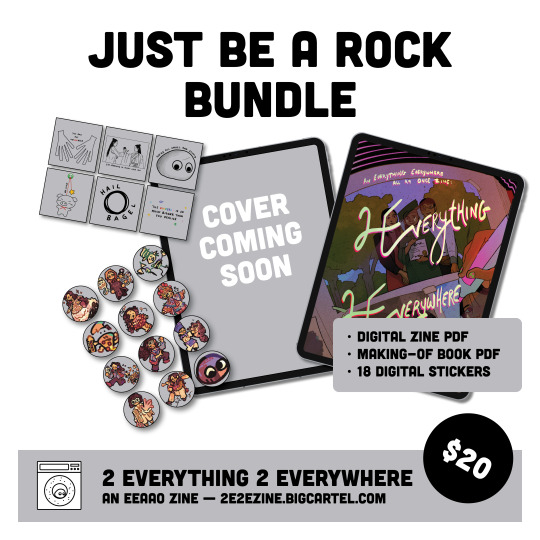




👁️ OPEN UP 👁️
Preorders for 2 Everything 2 Everywhere: An EEAAO Zine are NOW OPEN! Featuring art, writing, and merch from 36 contributors, this 80+ page fanzine will rock your universe.
🛒 2e2ezine.bigcartel.com ⏰ August 25 - September 25, 11:59pm EST
More information about bundles and stretch goals below!
˗ˏˋ BUNDLE INFORMATION ´ˎ˗
🪨 JUST BE A ROCK ($20)
This is sure to prove that things do matter. This digital bundle includes: - A PDF copy of the zine - A "The Making-Of" book PDF - 18 digital stickers
🦝 SOME THINGS ($27)
Get ready to jump across the multiverse! This zine bundle includes: - An A4 perfect bound physical zine - A PDF zine - All digital merch ("The Making-Of" PDF + stickers) ‼️ Eligible for the 50 orders stretch goal ‼️
🥯 MOST THINGS ($45)
Take a bite of this bagel. This flats bundle includes: - 2 die-cut stickers - 2 postcards (4x6″) - 2 sticker sheets (4x6″) - 3 prints (A5) - A physical zine - A PDF zine + all digital merch ‼️ Eligible for the 50 and 75 orders stretch goals ‼️
👁️ EVERYTHING ($60)
Everywhere, all at once. This full bundle includes: - A wooden charm - A magnet - 3 die-cut stickers - 2 postcards (4x6″) - 2 sticker sheets (4x6″) - 3 prints (A5) - A physical zine - A PDF zine + all digital merch ‼️ Eligible for ALL stretch goals ‼️
˗ˏˋ STRETCH GOALS ‼️ ´ˎ˗
We have 3 spectacular stretch goals we hope to unlock by reaching the following milestones: - 50 orders unlock a bonus postcard - 75 orders unlock an acrylic charm - 100 orders upgrades a die-cut sticker to an enamel pin
*This is a non-profit, charity zine! All profits raised (beyond production and shipping fees) will be equally split and donated to Red Canary Song, Asian Mental Health Collective, and Send Chinatown Love. Read about each charitable organization HERE!
#everything everywhere all at once#eeaao#zine#zines#fanzines#fanzine#charity zine#film zine#fandom zine#film#films#zine-scene#zinefeed#zine promo#zine preorders#zine pre orders#zine sales
202 notes
·
View notes
Text
Alright!
Here are the Elric Raffle of the Century that Only Happens Once Every 100 Followers Spectacular©®™ winners!
According to the 100% neutral judgement of the Oratrice Mecanique d'Analyse Cardinale...
1st Place prize for a free art prompt goes to... Rose!
2nd Place prize for a free doodle prompt goes to... Leah (on Twitter)!
3rd Place prize for 50% off on their next commission goes to... @rxinbowtrxveler!
Before anyone assumes this shit was rigged, it wasn't. Only 6 people entered and 2 of them had to be (unfortunately) disqualified. I used "the wheel of names" to randomly choose the winners and those were the honest to God results.
Ngl, I was expecting a bigger turn out considering the prizes were sort of free art 😅
Price ref⬇️
* Doodles: $25
* Sketches: $60
* Bust (lines): $70
* Bust (lines + shading): $75
* Bust (color): $80
* Torso (lines): $75
* Torso (lines + shading): $80
* Torso (color): $85
* Full body (lines): $95
* Full body (lines + shading): 110
* Full body (color): $120
* Full render: $180
* Pinups: $300
* More than 3 characters: +$80
* More than 5 characters: +$115
* More than 10 characters: +$200
* Revisions: $65 per change
Comic prices:
* Lines: $80 per page
* Lines + shading: $95 per page
* Color: $120 per page
* Revisions: $65 per change
Animation prices:
* $13 per hour
* Revisions: $65 per change, +hours spent changing it
Sale:
* Rendering unfinished wips: $25
14 notes
·
View notes
Note
Have you thought about opening a Patreon? I would pay a lot of money if it meant getting your stories more regularly...
My prose sucks, yours is spectacular. How do I get better at it? I try reading a lot, but I'm starting to conclude there's only so much you can pick up via absorption without some kind of formal instruction.
1. I'm not especially interested in opening a Patreon, and here's why. First, I work a reliable full time job that isn't too demanding on me, so I'm already financially stable. My following right now likely isn't large enough to sustain me full time, so I wouldn't be able to use Patreon as a primary income source anyway. Even if my following was larger, though, it would be a gamble to quit my job and sustain myself solely on fan donations. Ultimately, it would probably be more stressful for me than my current situation, and I could see my writing quality suffer under the pressure of needing to constantly output material on a monthly basis. On top of that, I'm not sure if sustaining myself on Patreon would actually increase the regularity of my stories. Unlike seemingly most authors (go look at Alexander Wales' Tumblr for an example), I'm not an "ideas guy." I don't get a lot of story ideas. The ideas I do get I nurture for years, slowly adding details to them until they're ready to write. Cockatiel x Chameleon was an idea I got in 2015 (published 2022). Modern Cannibals was an idea I got in 2012 (published 2017). When I am actually writing a story, I'm usually able to consistently output content, even with my job. The limiting factor for me isn't my available time in the day, but my brain. I appreciate the sentiment, though! One of my favorite comments, which I received on Cockatiel x Chameleon, went something like "You should be on humanity's payroll."
2. My prose sucked too. When I was a teen, I would write stories and my classmates would laugh at how badly written they were. In college, I couldn't even get my friends or family to read my stories. (I once described one of my stories to my grandmother and she said, "Well that doesn't sound any good at all.") At age 18, I decided to start reading classic literature. Only classic literature, at a rate of 50 pages a day, every day. I read all kinds, from all sorts of time periods and countries. I read everything from Homer to David Foster Wallace. And while I read, I wrote. I wrote badly. In college I wrote novels that pretty shamelessly imitated the prose styles of Faulkner and Cormac McCarthy. By the time I started writing Fargo (which is a story where I think my prose was still improving), I had written nine complete novels and had read somewhere between 200 and 300 works of classic literature. I didn't have any formal training, at least in terms of writing fiction. I was an English/Geography dual major, and from my English classes I learned how to close read a text, and in general I learned how to write an academic essay. In my final year of college I took an MFA-styled creative writing workshop, but by then I was pretty much beyond what it could teach me and I don't feel like I learned much of anything from it.
Other than reading and writing, I started editing. One of my later pre-Bavitz novels I finished, then went back and edited assiduously. I took a 100,000 word rough draft and over 14 editing passes pared it down to 70,000 words. That was massive for improving my prose, as it forced me to engage with my story on a word-by-word level. Every single word fell under my scrutiny and thus I had to grapple with how valuable, how good that word was. What I learned from that experience was massive for improving my prose going forward.
I think it's entirely possible for someone to improve their prose just through the basics of reading, writing, and editing. Julirites, the author of Fargo fanfic London, has massively improved her prose over the course of the story. It didn't even take her nine failed novels to do it, either. Be willing to experiment. Be willing to fail. Don't be afraid of someone laughing at you for writing purple prose. Imitate authors you like, that's the first step toward developing your own unique style.
20 notes
·
View notes
Text
It was the best of times. It was the worst of times.
What a year!
It was actually spectacular in many ways for me despite the enormous challenges.
_________Best of Times:__________
3 weeks in Bolivia
Salar de Uyuni
Brain improvement
The full force return of self-confidence
Finally understood self-worth
Deepened friendships
A week in Playa del Carmen
Mini break at Ormond Beach
Wrote 3 curriculums
Big improvement in marriage; communication & forgiveness
Established a meditation/poetry practice in the morning
Got both children enrolled in an aviation technical college
Home improvements: impact windows, tree trimming that was desperately needed, new roof on writing cottage, massive deck improvements, new lawn
Pink sapphire ring and repair on my engagement ring
Cousin visited
Bestie/ Cousin/ soul sister visited
Turning 50!
So much astrology fun
Lots of chances to tour beautiful gardens
Did not let the election results destroy me (I was so afraid of this)
__________Worst of Times:____________
Husband’s stage 4 cancer diagnosis and treatment
Tottering near divorce (beginning of year)
Sprained ankle
Pertusis
RSV
Gaining a significant amount of weight
Husband losing job
Teenagers being teenagers
Didn’t launch my company
The election results
*******
I think it would be easy to just write off the year and say it was terrible because cancer, but my life has a story that is separate and distinct from my husband’s. I am sure this was the worst year of his life and that affected me and colored my life in terrible ways.
But also, I closed a seven year cycle of suffering that began when my mom died and was followed by my brain injury. I think perimenopause intensified it all. It was just awful, awful, awful. Every time I clawed my way out of pit, I was knocked back down.
For 7 years!
Going to Bolivia, taking that leap of faith that I could handle it— hands down the best decision of my life. I restored myself to myself. I remembered that I was wonderful and capable, qualities that felt gone for good for so long. Inside of me, monumental changes took place. It changed the way I interact with the world. I feel more in control, as poised to surf the tsunami. I am not afraid to be myself anymore.
Watching my husband suffer was really hard. Getting very sick and watching him get so very sick was really hard. That’s what caused the weight gain (weight is a huge emotional issue for me, former ED). But honestly, considering how hard it was, I think I’ve handled it really well. I was able to help but also put some parameters around the situation to protect my own fragile happiness.
I am excited and daunted by what 2025 has in store for me. But deep down, beneath the surface jitters of anxiety, I know I am up for the challenge.
11 notes
·
View notes
Text
✨Major Astrological events and Planetary Transitions of 2025✨
✨ Major Astrological Events & Planetary Transits of 2025! 🌙🔮
Get ready for a cosmic journey! 🚀 2025 is brimming with powerful Full Moons, transformative Eclipses, and significant planetary shifts. Here’s your ultimate guide to the year’s celestial highlights. 🌟💫
🌑 New Moons (Fresh Starts & Manifestation)
• Jan 29 – Set intentions for the year ahead! 🌱
• Feb 28 – Dream big and take action! ✨
• Mar 29 – 🌘 TOTAL SOLAR ECLIPSE (Embrace transformative energies!)
• Apr 27 – Super New Moon! Supercharged fresh start! ⚡
• May 27 – Plant the seeds of success. 🌿
• Jun 25 – Focus on home, family, & emotional healing. 🏡💖
• Jul 25 – Another Super New Moon – double the magic! 🔥
• Aug 23 – Black Moon (Rare & potent – time to delve deep!) 🌑
• Sep 22 – Seek balance & harmony. ⚖️
• Oct 22 – Engage in transformation & shadow work. 🌒
• Nov 20 – Micro New Moon (Subtle energy for introspection). 🕯️
• Dec 20 – Manifest your 2026 dreams early! 🎇
🌕 Full Moons (Release & Clarity)
• Jan 13 – Wolf Moon 🐺 Time for deep reflection.
• Feb 12 – Snow Moon ❄️ Build resilience & inner strength.
• Mar 14 – Worm Moon + Penumbral Lunar Eclipse 🌘 Emotional shifts incoming!
• Apr 13 – Pink Moon 🌸 A season of renewal begins.
• May 12 – Flower Moon + TOTAL LUNAR ECLIPSE 🌕💥 Significant transformation & emotional breakthroughs.
• Jun 11 – Strawberry Moon 🍓 Abundance is on the horizon!
• Jul 10 – Supermoon! Buck Moon 🦌 Step into your power.
• Aug 9 – Supermoon! Sturgeon Moon 🌊 Persevere & trust the journey.
• Sep 7 – Supermoon + Partial Lunar Eclipse! 🌑 Major karmic endings.
• Oct 7 – Supermoon! Hunter’s Moon 🎯 Pursue your goals with determination!
• Nov 5 – Beaver Moon + TOTAL LUNAR ECLIPSE 🌔 Release old patterns.
• Dec 4 – Supermoon! Cold Moon ❄️ Gain clarity & complete cycles before 2026.
🔥 Eclipses (Catalysts for Change!)
• Mar 14 – Penumbral Lunar Eclipse 🌘 Emotional revelations.
• Mar 29 – TOTAL SOLAR ECLIPSE 🌑 Life-altering shifts! (Visible in Canada 🇨🇦)
• Sep 7 – Partial Lunar Eclipse 🌕⚡ Karmic conclusions.
• Sep 21 – Partial Solar Eclipse ☀️ Significant decisions ahead!
• Nov 5 – TOTAL LUNAR ECLIPSE 🌕💫 Deep emotional release.
🪐 Major Planetary Transits & Alignments
• Jan 4 – Mercury enters Sagittarius 🏹 Expand your horizons and embrace new philosophies.
• Jan 28 – Venus enters Pisces 🐟 Heightened empathy and artistic inspiration.
• Feb 14 – Venus, Mars, Jupiter & Saturn align! 💞🔥 Passionate and expansive energies converge.
• Feb 25 – Planetary Parade! 🌎✨ Mercury, Venus, Jupiter, Saturn, and Mars all visible.
• Mar 1 to Apr 12 – Venus Retrograde in Aries & Pisces 🔄 Revisit past relationships and artistic endeavors.
• Mar 8 – Mercury at Greatest Elongation – Optimal time for evening visibility. 🌠
• Mar 14 – Sun enters Pisces 🌊 Dive deep into intuition and spiritual growth.
• Mar 30 – Neptune enters Aries 🔥 Initiate new spiritual journeys and embrace visionary ideas.
• Apr 12-18 – Mercury, Venus & Saturn cluster 🌌 A unique celestial gathering.
• May 24 – Saturn enters Aries 🐏 Time to take responsibility and initiate new structures.
• Jun 9 – Jupiter enters Cancer 🦀 Focus on emotional security and nurturing connections.
• Jul 7 – Uranus enters Gemini 🌬️ Embrace innovative communication and revolutionary ideas.
• Aug 12 – Venus & Jupiter Conjunction 🌟 Love and luck unite!
• Sep 19 – Lunar Occultation of Venus 🌙💖 Hidden aspects of love and beauty revealed.
☄️ Meteor Showers
• May 3-5 – Eta Aquarids 🌠 Up to 50 meteors per hour! Best viewed before dawn.
• Dec 13-14 – Geminids 💫 Over 100 meteors per hour – one of the year’s most spectacular displays!
📌 Save this post to stay updated on all major cosmic events! ✨ Which event are you most excited about? Share your zodiac sign in the comments! ⬇️♈♉♊♋♌♍♎♏♐♑♒♓
✨Follow✨
✨The✨
✨Lantern’s✨
✨Glow✨
#2025#witchcraft#paganism#yule#folklore#magic#astrology#planetary magic#planetary transition#cosmicweatherreport#cosmic#follow the lanterns glow
6 notes
·
View notes
Text
youtube
“INTERVIEW - Ben Affleck, Oscar Isaac, Charlie Hunnam & Garrett Hedlund” by SensCritique
Transcript by @ casual-video-transcripts is under the cut
[0:00] Charlie Hannam: Kamikaze!
[0:01] (Ben Affleck laughing and Charlie Hunnam chuckling followed by a clap from Ben)
[0:02] Oscar Isaac: Woof woof!
(Garrett Hedlund giggling)
[0:03] Oscar: Are we trained animals?
[0:05] (Translating On-Screen Text to English: Triple Frontier)
[0:06] (On-Screen Text: Ben Affleck)
[0:07] (On-Screen Text: Charlie Hunnam)
[0:08] (On-Screen Text: Oscar Isaac)
[0:09] (On-Screen Text: Garrett Hedlund)
[0:10] Charlie: Hello SensCritique!
[0:11] Garrett and Oscar: Hello SensCritique!
[0:13] Ben: Bonjour SensCritique.
[0:14] That's French.
[0:15] Charlie: There you go! Wha-cha-cha!
[0:18] (Translating On-Screen Text to English: CAN YOU SUMMARIZE THE FILM?)
[0:20] (Translating On-Screen Text to English: IN ONE SENTENCE)
[0:22] Oscar: See, the thing is one sentence can be veeeeery long...
[0:24] Garrett: Yeah, yeah, yeah.
[0:25] Oscar: So you can put commas!
[0:26] Garrett: Just commas.
[0:27] Ben: A group of ex-Special Forces soldiers...
[0:30] Oscar: come together to... carry out a heist in South America against a narcos traficante.
[0:39] Ben: Turns out, it wasn't that hard.
Charlie: Right?
[0:40] (Ben and Charlie laugh)
[0:41] (Translating On-Screen Text to English: HOW DID YOU GET INVOLVED WITH THE PROJECT?)
[0:45] Ben: It was a combination of genres: it was strong, compelling, pure action heist story, but so was also a morality tale, and sort of-kinda a parable about military intervention.
[0:57] Charlie: Between the cast and the script, and me being excited for J.C. as a filmmaker, it was a no brainer for me. He was looking at a friend of mine, Garrett Hedlund.
[1:04] Garrett: And he had no idea about that, and got really excited about that. And then I got excited about that. And then Oscar called and said -
[1:10] Oscar: Got excited too.
[1:11] (Garrett laughs)
[1:12] Garrett: And he got excited too!
[1:13] Oscar: And then you guys said that -
[1:15] Garrett: And then I got excited because he was excited and you know -
[1:19] (Translating On-Screen Text to English: WHAT IS YOUR FAVORITE FILM?)
[1:21] (Translating On-Screen Text to English: WITH YOUR CO-STAR/NEIGHBOR)
[1:22] Garrett and Oscar: Inside Llewyn Davis!
[1:23] (Translating On-Screen Text to English: (they both play/star in it))
[1:24] (Garrett and Oscar are in a giggling fit)
[1:27] Charlie: I like The Town a lot, there was Argo, Gone Baby Gone. You know...
[1:31] Ben: There we go.
[1:32] Charlie: Really really really...
[1:33] Ben: Oh wow.
Charlie: Spectacular stuff!
[1:34] Oscar: He's an iconic guy.
[1:36] Garrett: And he's says that! He's got that! He's Llewyn!
[1:38] Oscar: Yeah, yeah.
[1:39] Garrett: And that's iconic.
[1:40] Ben: And I like Charlie as a person.
[1:42] Charlie: Yeah (and then laughs)
[1:43] Ben: So... Hard to pick a favorite!
[1:45] (Charlie laughs and then Ben laughs after)
[1:47] Charlie: I'm not gonna help ya. Come on!
[1:49] (Ben leans towards the camera and continues laughing)
[1:50] Charlie: We're all waiting!
[1:52] Ben: I would say...
[1:54] (Take a shot of water every time Ben and Charlie laugh LOL)
[1:55] Ben: Did I tell you I watched The [Lost] City of Z.
[1:57] Charlie: Oh no you didn't!
[1:58] Ben: Yes, it was quite good! After I haven't seen it initially, and then when I got to know him - I've seen Sons of Anarchy, it's great. That's the thing everybody knows! And I've seen the King Arthur movie too! He's a first class actor.
[2:09] (Translating On-Screen Text to English: WHAT IS YOUR NEXT PROJECT?)
[2:11] (Translating On-Screen Text to English: WE WANT THE EXCLUSIVE)
[2:12] Ben: Wow, that's a tall order.
[2:13] Charlie: (chuckles) Yes, it is!
[2:15[ (Ben chuckles)
Charlie: You don't ask for much, do ya?
[2:16] Garrett: Ed Harris did the adaptation of a book called The Ploughman with myself and Robert Duvall. It's a two-hander, like a 70s deputy outlaw kind of thing.
[2:26] Charlie: I just did a thing - a movie with Justin Kurzel. The next thing that comes out is a film about Ned Kelly. This is the first time on camera that I'm talking about it, and that's all you get.
[2:37] Ben: I did a movie, it doesn't have a title, but with the Gavin O'Connor who is the director, he's the director of The Accountant. Yeah, that'll be out late summer, early fall time.
[2:45] Oscar: I'm also doing a small sort of sci-fi movie. It's called Star Wars Episode 9.
[2:51] Garrett: It's kinda - It's a smaller budget kinda thing.
[2:53] Oscar: Yeah.
[2:54] Garrett: It's very hard in cinema: you know, if it's not a very big budget thing, you know it's a small budget thing. The... the... Space Wars.
[3:02] Oscar: Space Fights?
[3:03] Garrett: Space Fights.
[3:04] Oscar: (chuckles) Yeah.
End of Transcript

YouTube Channel: SensCritique
Video Description:
Le plus beau cast de toutes les interviews SensCritique. Pour la sortie de "Triple Frontière", le nouveau film de J.C Chandor, aujourd'hui sur Netflix, nous avons eu la chance de rencontrer Ben Affleck, Oscar Isaac, Charlie Hunnam et Garrett Hedlund !
La fiche SensCritique du film : http://bit.ly/2HwvcEG
Disclaimer: None of the videos I transcribe belong to me. They belong to the content creators and the crew behind the videos. Please keep in mind that my transcripts may not be 100% as I am not a professional. I'm just someone who wants to provide video transcripts for people like me to understand and enjoy these videos.
For this video, I focused on the speakers while translating some of the on-screen text from French to English. I used the French captions in the video as a guide for the timestamps. I did also use Google translate for some of the French captions, so I apologize if some are incorrect. For the rest of the transcript I just followed whatever came out of the guys' mouths.
If there are any corrections you would like me to make, let me know in the comment section of the post.
If you like this video or any other videos from SensCritique, please support them by watching their videos on their YouTube channel and/or through other means by them. Also, if you want to support the film, it's on Netflix and apparently the sequel is in the works with Charlie as a main producer. Also, if you'd like, check out the filmography of the cast like Charlie Hunnam, Ben Affleck, Garrett Hedlund, Oscar Isaac, and Pedro Pascal (who's not in this interview but is in Triple Frontier interviews).
Personal Notes: So I got distracted while editing the mera video transcript and found myself back into the Triple Frontier fandom. I haven't been here since 2019 so it's been a hot minute. I transcribed this video because there is a section in the middle that is so funny to me that I almost had to hold my breath transcribing it. Rewatching these interviews really shows the golden retriever personality of Garrett that I didn't fully notice until like a few month ago when I got distracted back into the Triple Frontier and Garrett fandom. The video is funny because it literally cuts Garrett off because he got excited that Charlie was excited and Oscar was excited and -
Anyways, I don't know when I'll finish the mera video I have been working on. I think it's been maybe half a year. When I finally finish it, I'll probably schedule a series of reblogged posts that'll hint to it. In the meantime, I think I did transcribe a Triple Frontier-related video that has Pedro in it so keep an eye on that among other videos.
That's all for now. I'll catch you all in the next post. See ya!

#Youtube#triple frontier#ben affleck#oscar isaac#charlie hunnam#garrett hedlund#casual video transcripts#tom davis#santiago garcia#william miller#benjamin miller#tom redfly davis#santiago pope garcia#william ironhead miller#benny miller#ben miller
42 notes
·
View notes
Text
IRON MAIDEN ANNOUNCE 'RUN FOR YOUR LIVES' WORLD TOUR 2025/26!
The Run For Your Lives World Tour will kick off on May 27th next year in Budapest followed by 27 stadium, festival & arena shows around Europe. The tour marks 50 years since Steve Harris formed the band in late 1975 and to celebrate this Maiden fans are promised a very special set list, spanning the nine studio albums from ‘Iron Maiden’ to ‘Fear Of The Dark’, with their most spectacular and elaborate show ever!
MAY 2025
27 Budapest, HUNGARY - Budapest Aréna *
31 Prague, CZECH REPUBLIC - Letnany Airport *
JUNE 2025
01 Bratislava, SLOVAKIA - TIPOS Arena *
05 Trondheim, NORWAY - Trondheim Rocks (Festival)
07 Stavanger, NORWAY - SR-Bank Arena *
09 Copenhagen, DENMARK - Royal Arena *
12 Stockholm, SWEDEN - 3Arena *
13 Stockholm, SWEDEN - 3Arena *
16 Helsinki, FINLAND - Olympic Stadium *
21 Birmingham, ENGLAND - Utilita Arena ^
22 Manchester, ENGLAND - Co-op Live ^
25 Dublin, IRELAND - Malahide Castle *^
28 London, ENGLAND - London Stadium *^
30 Glasgow, SCOTLAND - OVO Hydro ^
JULY 2025
03 Belfort, FRANCE - Eurockéennes Festival
05 Madrid, SPAIN - Estadio Cívitas Metropolitano **
06 Lisbon, PORTUGAL - MEO Arena **
09 Zurich, SWITZERLAND - Hallenstadion **
11 Gelsenkirchen, GERMANY - Veltins-Arena **
13 Padova, ITALY - Stadio Euganeo **
15 Bremen, GERMANY - Bürgerweide **
17 Vienna, AUSTRIA - Ernst Happel Stadium **
19 Paris, FRANCE - Paris La Défense Arena **
23 Arnhem, NETHERLANDS - GelreDome **
25 Frankfurt, GERMANY - Deutsche Bank Park **
26 Stuttgart, GERMANY - Cannstatter Wasen **
29 Berlin, GERMANY - Waldbühne **
AUGUST 2025
02 Warsaw - POLAND - PGE Narodowy **
Special Guests for the first half of the tour, including the London & Dublin outdoor shows (but not the UK arenas), will be American rockers Halestorm. The second half of the tour sees Sweden’s Avatar as guests. And, finally, British metal band, The Raven Age, will open all UK & Ireland shows.
*Halestorm | ^The Raven Age | **Avatar
Fan Club Presales begin Monday 23rd September – details here.
Tickets go on general sale next week – check the tour dates page for times and dates.
Says Bruce Dickinson, “Next year is a very special one for IRON MAIDEN and we’re going to be giving our fans a once-in-a-lifetime live experience. This is a tour that’s gonna put a smile on your face and a cheer in your throat. If you’ve seen us before, then get ready to take that experience to a whole new level. If you’ve never seen us before, then what the hell have you been waiting for? Now’s your chance to find out what you’ve been missing! IRON MAIDEN’s definitely gonna get ya!”
Manager Rod Smallwood adds, “50 years of Maiden and I have seen 46 of them! With well over 100 million albums sold and almost 2500 shows in 64 countries and counting, to countless millions of fans, we are all still loving every second and consider every tour a new challenge to bring something different and exciting to our fans. And for this very special one we’re pulling out all the stops!
"We will cover classics and fan favourites from the first nine albums, from IRON MAIDEN to FEAR OF THE DARK, many of which we haven’t played in years and many we will likely never play again in the future. We have already been hard at work for months putting together an even more spectacular and elaborate new show which will bring the songs to life more than we have ever been able to do before. This is going to be a huge couple of years for IRON MAIDEN, and Eddie of course, and we are very excited about what we have up our sleeves for you fans throughout the whole of our 50th year. I promise you are all going to be very happy indeed!”
On Saturday June 28th the band will perform at the London Stadium, home of West Ham Football Club – the team that band founder Steve Harris has supported throughout his life, and with whom IRON MAIDEN have a long and storied history.
This concert in front of over 60,000 fans, will be the first time that IRON MAIDEN have performed on the club’s hallowed turf. A true homecoming show – with Steve Harris, Dave Murray, Adrian Smith & Nicko McBrain all born in the surrounding area – it will also be the biggest UK venue the band have ever headlined outside of their festival appearances.
Steve Harris says, “My love of football and my support of West Ham is no secret, and I know many of our fans around the world have shared that with me too. So we’re all very excited to be playing at the London Stadium as part of the RUN FOR YOUR LIVES tour. We can’t wait to see you all there!”
#iron maiden#bruce dickinson#steve harris#dave murray#adrian smith#nicko mcbrain#janick gers#run for your lives world tour#cries in American 😭
9 notes
·
View notes
Text


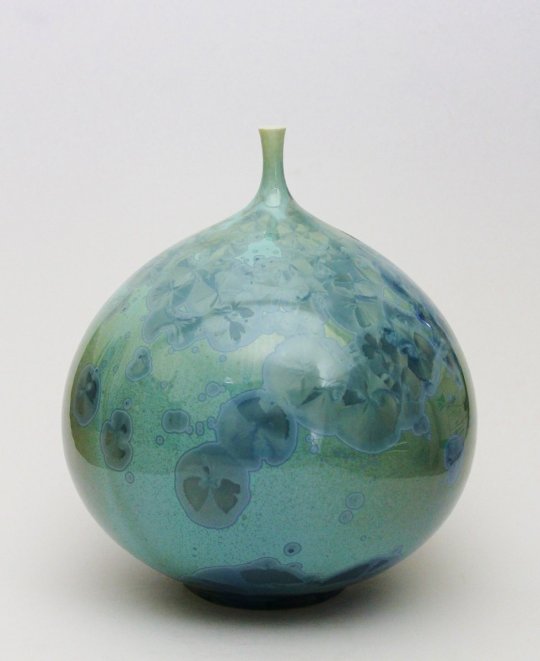

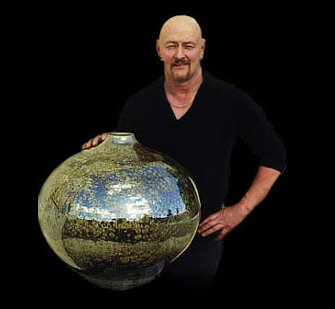
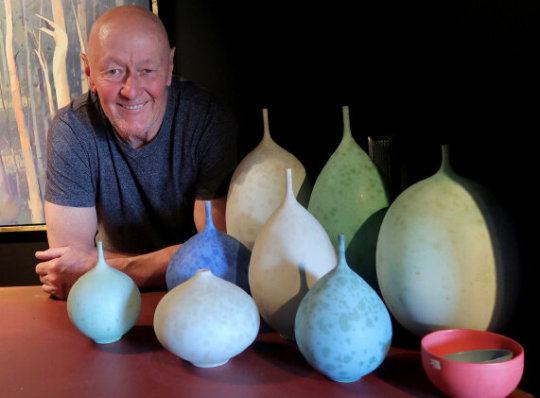
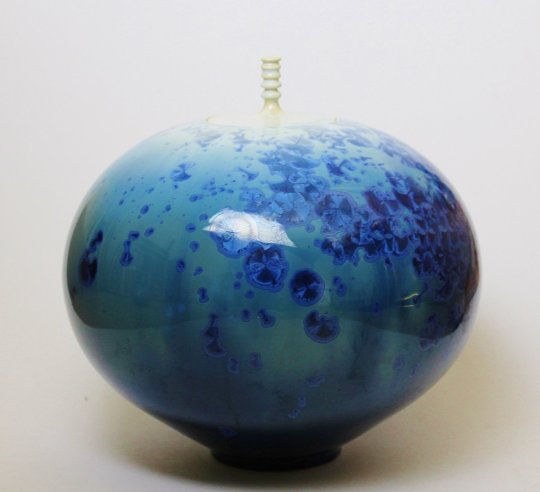

Described as a ‘Virtuoso of the potter’s wheel’ by Peter Timms, Art Critic for the Melbourne Age John Stroomer is a master potter who is internationally recognized for his work with Crystalline Glazes. His forms are classical, balanced, simple, full bodied and reflect his mastery of both the potter’s wheel and crystalline process.
“I have been making for almost 50 years, employing 23 potters during the 80s/90s supplying wheel thrown domestic stoneware to major retailers, direct selling companies and homeware stores Australia-wide.
The recession of 1981, a devastating factory fire in 1988 followed by the 1990 recession and subsequent fluctuating market forces eventually led to a change in personal philosophy/direction. They were all pivotal in leading me to where and who I am today.
The exacting nature, temperature control, balance and understanding of materials and glaze technologies demanded by the Crystaline process reflect John’s mastery of his craft over many years. Each pot is fired at over 1,300 Degrees Celsius for at least 18 hours. Once peak temperature has been reached, the kiln is rapidly cooled to pre-determined temperatures, at which point the crystals begin to be formed. As crystal formation requires slow cooling, the temperature is held and slowly reduced/managed with a crystal growth period of an additional six hours.
Crystals can take on a myriad of shapes and are three dimensional in nature. In direct sunlight or strong light, spectacular effects can be created by the refraction of light bouncing off the crystals, giving each pot a true three dimensional appearance.
Metallic oxides and combinations of various materials are used to produce a wide range of colours, ranging from dark browns, to cobalt blues and coral greens, amongst many others.
The end result are a range of pots that are exquisite.
29 notes
·
View notes
Text

Of course the Sabre was the most important Cold War aircraft, here’s why
Hush KitSeptember 27, 2022
The Cold War took a brief rest between the early 1990s and the 2010s, but serious tension between the largest former Soviet nation and the West has now returned. At the forefront of the original Cold War was air power, and this fearful age sired a multitude of incredible and often long-lived warplanes. In the second of a series of articles written by pilots and subject experts, we consider the question of which Cold War military aircraft was the most important. Let us turn start to Peter E Davies case for the F-86 Sabre.
In 1954 the massive Nellis Air Force Base in Nevada, later to host Red Flag and other spectacular USAF training activities and projects, was already an exciting place for new pilots. It hosted the F-86 Sabre, the world’s premier fighter at the time and one which became a seminal influence on most subsequent fighter designs. Sabre pilots had roundly defeated communist MiG-15s over North Korea, and many of those wartime pilots (including seventeen aces) were now instructors at Nellis. For new trainees the chance to join that exclusive fraternity was compelling. The Sabre’s reputation as the West’s first true jet dogfighter was well established. Before technology took over the combat cockpit it was also the last fighter in the tradition of the Spitfire and Mustang in which the pilot had full manual control. During the Cold War the Sabre and its pilots kept alive the dogfighting tradition at a time when caution and cost-cutting in training programs actually prevented many trainee pilots from indulging in realistic air combat manoeuvres. That continuity paved the route for a later generation of versatile air-fighters including the F-15 Eagle and F-16 Fighting Falcon. Conventional late-1950s wisdom advocated aerial combat with large aircraft firing missiles from long distances.
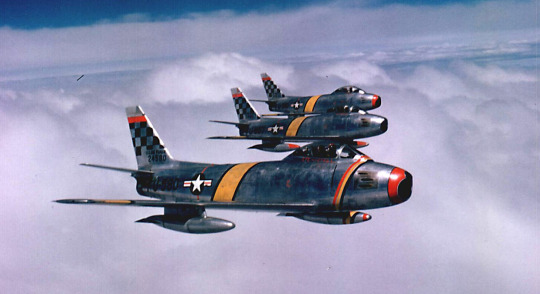
The Sabre’s outstanding combat record was founded in its design’s many technical advances at a time when most designers were still simply adding jet engines to WW II-style airframes. In 1943 North American Aviation (NAA), decided to avoid direct competition with Lockheed’s straight-winged F-80 Shooting Star, the USAF’s first successful jet fighter. The company initiated a new German-inspired wing in 1945, swept at 35 degrees. It was a bold step as the few previous swept-wing designs had exhibited instability problems. Large, automatic wing slats and hydraulically boosted ailerons were the innovative NAA solution, giving superb transonic handling. A unique blown plastic cockpit canopy gave all-round vision unequalled in fighters until the advent of the F-15 Eagle. NAA developed manufacturing techniques for a thin wing with machined-plate, double layer skins. The F-86E version introduced the now-universal powered, ‘all-flying’ tailplane.

Sabres retained gun armament, either the standard six .50 calibre machine gun fit or (in later Sabres) 20mm cannon. Guns disappeared from many other Cold War fighters in favour of missiles, but the Vietnam war showed that to be a mistake. However, the Sabre also pioneered the use of air-to-air missiles in the radar-equipped, all weather, rocket firing F-86D version (added in 1949). It included an early afterburner and a complex Hughes E-4 fire-control system. It became the most prolific Sabre variant with over 2,500 manufactured, pioneering radar-based interception in many air forces of the Cold War era.
Early jet engines of the time were often unreliable, but NAA designers chose the best available option, the Allison J35 in the F-86 prototype which first flew on October 1, 1947 and achieved supersonic flight in a shallow dive the following year as the first service-capable fighter to achieve that speed safely. The engine was replaced by the General Electric J47, also selected for the B-47 Stratojet bomber. It became an outstanding powerplant in Korean combat and effectively proved that jet fighters could be as effective and reliable as their prop-driven predecessors – and a lot faster. Cold War fighter designers throughout the world benefited from that bonus.
When the Korean War began in June, 1950 the small Allied air forces in South Korea relied on WW II propeller-driven aircraft and early, straight-winged F-80 and F-84 jets. None matched the Soviet MiG-15, a broadly similar swept-wing jet to the Sabre. F-86As were urgently deployed to counter this unanticipated threat. Despite the MiG-15’s altitude advantage and its pilots’ proximity to their home bases the outnumbered, but better-trained Sabre pilots soon regained air superiority. It was a scenario to be repeated in many respects in Vietnam over a decade later.
The Sabre’s success and influence are demonstrated by its unusually widespread use. Overall production ran to almost 9,000 aircraft, with licence production in Canada, Japan, Italy and Australia. No fewer than 35 air forces used Sabres, making it the most numerous Western Cold War jet fighter and giving many of those users entry to the jet age. It equipped many NATO nations, including Great Britain, to face the growing Soviet threat following the Berlin crisis in 1949. Some continued in service, and occasional combat until the mid-1980s.The US Navy’s used F-86 derivatives, culminating in the very capable, long-range FJ-4B fighter-bomber. They equipped 22 USN and USMC squadrons up to 1962. In US Navy training sessions a well-flown F-86 regularly beat F-4 Phantom and F-8 Crusader pilots in dogfighting practices.

An F-86 pilot allegedly achieved supersonic flight shortly before Chuck Yeager’s official sound barrier-smashing flight in 1947, but it was the success rate of twelve-to-one against MiG-15s (later to be scaled down to a still creditable 4:1) that lent the Sabre an almost legendary status and reminded future fighter designers that manoeuvrability, ease of operation and gunfighting capability were still relevant in the supersonic era. While some might champion aircraft like the Hawker Hunter, F-4 Phantom or MiG-21 as the most influential Cold War fighters there is no doubt that the F-86’s wide range of ground-breaking achievements in design and worldwide service easily give it that accolade.

Peter E Davies. September 2022, Peter Davies is based in Bristol and has written or co-written 16 books on modern American combat aircraft, including four previous Osprey titles and the standard reference work on US Navy and Marine Corps Phantom II operations, Gray Ghosts.
42 notes
·
View notes
Text
It's time for the Elric Raffle of the Century that Only Happens Once Every 100 Followers Spectacular!©®™
How to enter ⬇️
Rules are simple:
1. Be a follower either here or Twitter prior to this post and show you're 18+ in your bio. Minors are not welcome here for a reason. If you don't have proof of adulthood, you will be disqualified.
Note: I'd include the Bluesky (@elricart.bsky.social) followers but I don't get a lot of traction there. Maybe when I get 100 followers there I'll do it just for them.
2A. For those on Tumblr: Reblog this post and tag it as #Elric Raffle or something stupid like #EdmodsNumber1Fan ⬅️ That's a suggestion, don't take it seriously.
2B. For those on Twitter: Retweet the post linking you to this one and tag it as #ElricRaffle or something stupid like #EdmodNeedsABoost ⬅️ Again, still a suggestion.
2C. Have your Tumblr/Twitter DM's open for when the time comes.
Note: I am extremely shy and would prefer to keep to myself after all is done. Please forgive me but I just want satisfied clients.
3. One account per person, side blogs don't count. If I found out you cheated you'll be blacklisted.
4. Winners shall be chosen randomly.
5. Users who try to participate and fail to follow the rules shall have their usernames displayed in a frame and mounted over me fire place. I will literally draw this, don't test me. I'll do it, I'll really do it. I'm gonna do it.
How it works:
1st Place: Free Art
The Catch: Prompt only, you'll be surprised like future parents at a gender reveal party.
2nd Place: Free Doodle
The Catch: One character, you'll be surprised like a Karen asking for the Manager only for the Manager to repeat the exact same thing the Clerk just said. No Karen, your credit ticket isn't a coupon. We need to have your credit IN the system SO THAT YOU CAN USE IT IN YOUR NEXT PURCHASE.
3rd Place: 50% off on next commission
The Catch: Cannot be stacked.
Deadline is 1/17/25 @ 8PM EST
Good luck!
12 notes
·
View notes